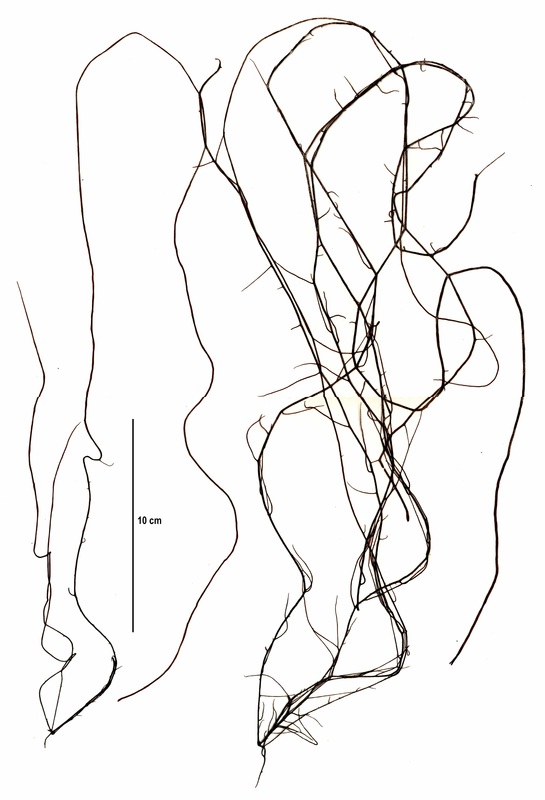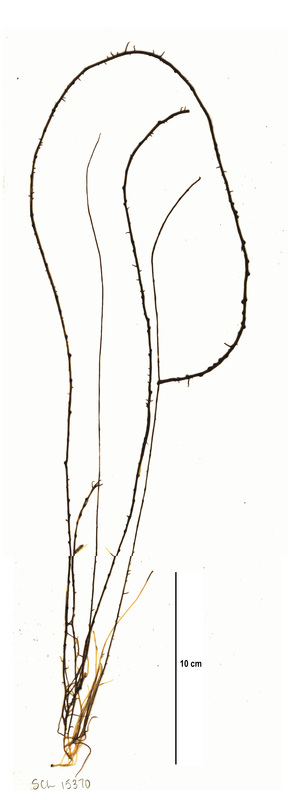Sea spaghetti, red spaghetti • Gracilariopsis andersonii, Gracilaria andersonii
Specimen collection numbers SCL 15318 (left and centre) and SCL 15370 in the UBC Herbarium Algae Databse. Search the collection number in the database for more information on this specimen, or search the species for further occurrences. Images courtesy of Sandra Lindstrom.
Identification
This red alga is reddish-brown to reddish-purple and may fade to yellowish-brown later in the growing season. As its common name suggests, the body of sea spaghetti is long (to 2 m in length) and narrow (to 2 mm wide), with a flexible, cartilaginous texture. It branches only occasionally, and has a small disc-shaped holdfast. Carposporophytes form small bumps (to 1.8 mm in diameter) along the branches.
Habitat & Range
Gracilariopsis species tend to grow intertidal and subtidal rocks on semi-exposed to exposed sandy beaches. Sea spaghetti grows in the mid-intertidal to subtidal, and is often found partially buried in sand and growing on smooth rocks. Its range extends from British Columbia to Mexico.
Similar Species
Species belonging to the Gracilariopsis and Gracilaria genera can be extremely difficult to differentiate and microscopic examination is usually required for a correct identification - though habitat can be helpful as the latter is more commonly found in sheltered subtidal locations. One example of a similar species also found on the Central Coast is California limu (Gracilaria pacifica), which is shorter (to 50 cm long) and grows in protected habitats.
Human Uses
Sea spaghetti is edible. One suggested use is as a salad ingredient: click here for a recipe from chef Ottolenghi.
Intriguing Info
A broken piece of sea spaghetti adrift in the ocean can continue growing; this may be a dispersal mechanism.
This red alga is reddish-brown to reddish-purple and may fade to yellowish-brown later in the growing season. As its common name suggests, the body of sea spaghetti is long (to 2 m in length) and narrow (to 2 mm wide), with a flexible, cartilaginous texture. It branches only occasionally, and has a small disc-shaped holdfast. Carposporophytes form small bumps (to 1.8 mm in diameter) along the branches.
Habitat & Range
Gracilariopsis species tend to grow intertidal and subtidal rocks on semi-exposed to exposed sandy beaches. Sea spaghetti grows in the mid-intertidal to subtidal, and is often found partially buried in sand and growing on smooth rocks. Its range extends from British Columbia to Mexico.
Similar Species
Species belonging to the Gracilariopsis and Gracilaria genera can be extremely difficult to differentiate and microscopic examination is usually required for a correct identification - though habitat can be helpful as the latter is more commonly found in sheltered subtidal locations. One example of a similar species also found on the Central Coast is California limu (Gracilaria pacifica), which is shorter (to 50 cm long) and grows in protected habitats.
Human Uses
Sea spaghetti is edible. One suggested use is as a salad ingredient: click here for a recipe from chef Ottolenghi.
Intriguing Info
A broken piece of sea spaghetti adrift in the ocean can continue growing; this may be a dispersal mechanism.
References
Druehl, L. 2000. Pacific Seaweeds: A guide to common seaweeds of the west coast. Harbour Publishing: Madeira Park, BC, Canada. Pp. 126.
Lamb, A., and Hanby, B. (2005). Marine Life of the Pacific Northwest [electronic version]. Madeira Park, BC: Harbour Publishing.
O'Clair, R. and Lindstrom, S. Gracilariopsis andersonii (Grunow) E.Y. Dawson. In Klinkenberg, Brian. (Ed.). E-Flora BC: Electronic Atlas of the Plants of British Columbia. Lab for Advanced Spatial Analysis, Department of Geography, University of British Columbia, Vancouver. Accessed 08/06/2015.
Authors and editors of page
Kelly Fretwell and Brian Starzomski (2015).
Druehl, L. 2000. Pacific Seaweeds: A guide to common seaweeds of the west coast. Harbour Publishing: Madeira Park, BC, Canada. Pp. 126.
Lamb, A., and Hanby, B. (2005). Marine Life of the Pacific Northwest [electronic version]. Madeira Park, BC: Harbour Publishing.
O'Clair, R. and Lindstrom, S. Gracilariopsis andersonii (Grunow) E.Y. Dawson. In Klinkenberg, Brian. (Ed.). E-Flora BC: Electronic Atlas of the Plants of British Columbia. Lab for Advanced Spatial Analysis, Department of Geography, University of British Columbia, Vancouver. Accessed 08/06/2015.
Authors and editors of page
Kelly Fretwell and Brian Starzomski (2015).






